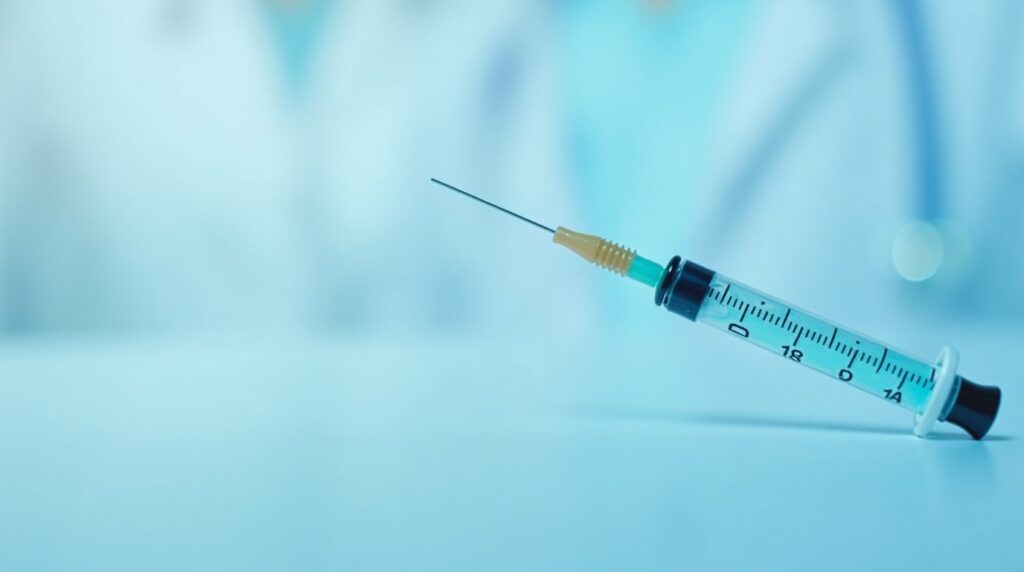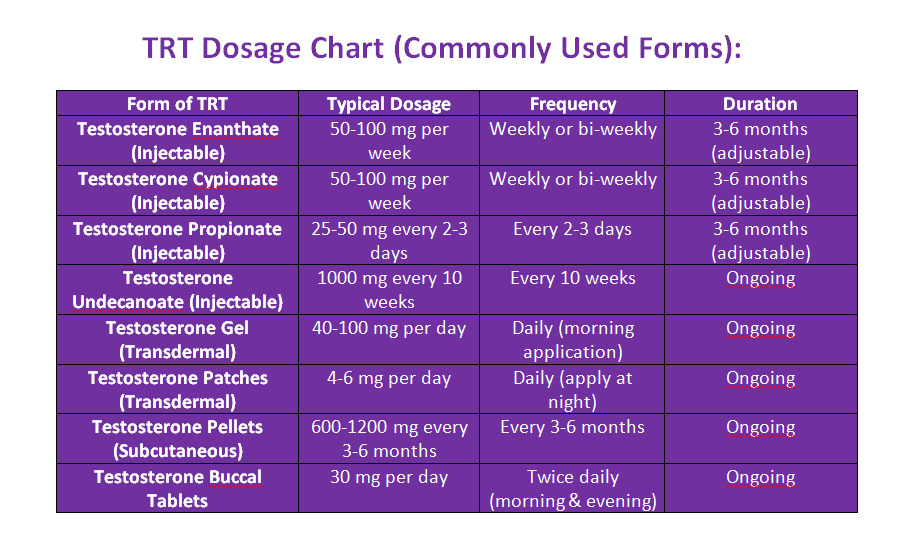Learn how to read the TRT dosage chart to find the optimal testosterone injection dosage. Achieve balanced hormone levels with the right testosterone treatment.
Have you been feeling fatigued, moody, or noticed a drop in your energy levels? These could be signs of low testosterone. If you’re considering Testosterone Replacement Therapy (TRT), you might be wondering how to determine the correct dosage for you. Whether you’re new to TRT or adjusting your current treatment, understanding the TRT dosage chart can help you find the right balance for optimal testosterone levels.

In this article, we’ll explore everything you need to know about the TRT dosage chart, how to use it effectively, and why maintaining balanced testosterone is key to improving your health.
What is TRT (Testosterone Replacement Therapy)?
Testosterone Replacement Therapy (TRT) is a treatment designed to raise testosterone levels in men and women with low hormone levels. As people age, testosterone production naturally declines, leading to symptoms such as fatigue, decreased libido, depression, and muscle loss.
TRT helps restore normal testosterone levels, which can improve mood, energy, muscle mass, and overall quality of life. The main challenge, however, lies in determining the right testosterone injection dosage to restore those levels effectively. That’s where the TRT dosage chart comes in.
Understanding the TRT Dosage Chart
The TRT dosage chart is a guide that provides recommended testosterone injection dosages based on the specific form of testosterone being used. This chart helps you determine the appropriate dose based on individual factors, such as your testosterone levels and health condition.
| Testosterone Form | Common Dosage | Injection Frequency | Duration Between Injections |
|---|---|---|---|
| Testosterone Cypionate | 50-200 mg per week | Once or twice a week | Weekly or biweekly |
| Testosterone Enanthate | 50-200 mg per week | Once or twice a week | Weekly or biweekly |
| Testosterone Propionate | 25-75 mg per injection | Every 2-3 days | Every 2-3 days |
| Testosterone Undecanoate | 750-1000 mg per injection | Every 10-14 weeks | Every 3-4 months |
| Testosterone Pellets (Implants) | 1200-1800 mg per implant | Once every 3-6 months | 3 to 6 months |
| Testosterone Buccal Tablet | 30 mg twice per day | Twice daily | N/A |
1. Testosterone Cypionate
- Dosage: 50–200 mg per week
- Frequency: Once or twice a week
- Description: Testosterone cypionate is one of the most commonly prescribed forms of testosterone replacement therapy. It is injected intramuscularly and typically requires weekly or biweekly injections depending on your doctor’s recommendations.
2. Testosterone Enanthate
- Dosage: 50–200 mg per week
- Frequency: Once or twice a week
- Description: Similar to cypionate, testosterone enanthate is another injectable testosterone form commonly used for TRT. It has a similar half-life and is injected intramuscularly once or twice per week.
3. Testosterone Propionate
- Dosage: 25–75 mg per injection
- Frequency: Every 2–3 days
- Description: Testosterone propionate has a shorter half-life compared to cypionate and enanthate, which is why it is injected more frequently. It is commonly used by individuals who require a more immediate effect.
4. Testosterone Undecanoate
- Dosage: 750–1000 mg per injection
- Frequency: Every 10-14 weeks
- Description: A long-acting form of testosterone, testosterone undecanoate is administered less frequently, making it a popular option for people who prefer fewer injections. It can be administered by healthcare professionals in an intramuscular shot.
5. Testosterone Pellets (Implants)
- Dosage: 1200–1800 mg per implant
- Frequency: Once every 3-6 months
- Description: Testosterone pellets are implanted under the skin and release testosterone over a period of several months. They require fewer interventions but may involve a minor surgical procedure to implant the pellets.
6. Testosterone Buccal Tablets
- Dosage: 30 mg twice daily
- Frequency: Twice a day
- Description: These tablets are placed on the gum or cheek and slowly release testosterone into the bloodstream. While not as common as injectable forms, buccal tablets are a good option for those who prefer non-injection methods.
Key Takeaways from the TRT Dosage Chart
- Frequency of Injections: Short-acting testosterone forms like propionate require more frequent injections, while longer-acting versions like undecanoate may only require injections every few weeks.
- Dosage Personalization: Your ideal TRT dosage depends on your current testosterone levels, age, health status, and doctor’s recommendations.
- Injection Sites: Most testosterone injections are intramuscular, but there are other methods, such as buccal tablets and subcutaneous pellets, which offer alternative options.
- Monitoring and Adjustments: Regular blood tests and consultations with your healthcare provider are essential to ensuring your testosterone levels are optimized throughout your therapy.
The specific dosage will vary based on individual needs and your doctor’s recommendations, but these general guidelines give you an idea of how testosterone replacement works.
Factors That Influence TRT Dosage
When determining your TRT dosage, several factors need to be taken into account. These factors can help personalize the dosage to ensure your testosterone levels remain optimal.
1. Age
As you age, testosterone naturally declines. Older men may need higher doses to restore normal levels compared to younger individuals.
2. Health Conditions
Certain conditions like obesity, diabetes, or high blood pressure can affect testosterone levels. Your healthcare provider will consider these factors when recommending your dosage.
3. Type of Testosterone
The form of testosterone prescribed also plays a role in determining dosage. Longer-acting forms like testosterone cypionate and enanthate are typically injected once or twice a week. Shorter-acting forms, such as testosterone propionate, require more frequent injections.
4. Your Target Testosterone Levels
The goal is to keep testosterone levels within the ideal range, typically between 300 and 1,000 ng/dL for most men. Your doctor will adjust the dosage to ensure your testosterone levels are where they should be for optimal health.
Testosterone Injection Dosage: Getting It Right
Testosterone injections are a common method of TRT. Here’s what you need to know about getting the right testosterone injection dosage:
- Testosterone Cypionate & Enanthate: These forms are injected once or twice a week in doses ranging from 50-200 mg per week.
- Testosterone Propionate: Due to its shorter half-life, testosterone propionate requires more frequent injections, typically every 2-3 days, with doses ranging from 25-75 mg per injection.
- Testosterone Undecanoate: This long-acting form is injected far less frequently, typically every 10-14 weeks, with a dosage of 750-1000 mg per injection.
Working with your doctor is key to determining the exact dosage and injection schedule that works best for you.
How to Read a TRT Dosage Chart
Using the TRT dosage chart is essential for understanding your testosterone therapy. Here’s a step-by-step guide to reading the chart:
Step 1: Measure Your Testosterone Levels
Your doctor will order a blood test to measure your current testosterone levels. If they’re below 300 ng/dL, you may be a candidate for TRT.
Step 2: Find Your Recommended Dosage Range
Once you have your blood test results, your doctor will refer to the dosage chart to suggest an appropriate dose. For instance, testosterone cypionate may be prescribed in a range of 50-200 mg per week.
Step 3: Follow Injection Frequency Guidelines
Different testosterone forms require different injection frequencies. Some forms are injected once or twice a week, while others require more frequent injections. Your doctor will give you specific instructions on how often you need to inject.

Benefits of Optimal Testosterone Levels
When your testosterone levels are balanced, you’ll notice several health benefits:
1. Improved Mood and Mental Clarity
Low testosterone levels can contribute to mood swings and feelings of irritability. Restoring optimal testosterone levels can improve your mood and mental clarity, helping you feel more focused and less anxious.
2. Increased Muscle Mass and Strength
Testosterone plays a crucial role in muscle development. With the right TRT dosage, you can increase lean muscle mass, improve strength, and combat age-related muscle loss.
3. Enhanced Energy and Vitality
Many people with low testosterone report feeling constantly tired. TRT can help restore your energy levels, making you feel more alert and active throughout the day.
4. Improved Sexual Health
Testosterone is vital for maintaining libido and sexual function. By restoring testosterone to healthy levels, TRT can help improve your sex drive and overall sexual health.
Conclusion
Finding the right TRT dosage is crucial for achieving and maintaining optimal testosterone levels. The TRT dosage chart provides a helpful reference, but your healthcare provider is your best resource for tailoring your treatment. Remember, your ideal dosage will depend on various factors, including your age, health condition, and testosterone levels.
If you’re considering or already undergoing TRT, working closely with your healthcare provider is essential to ensure the right dosage. Optimal testosterone levels can significantly improve your energy, mood, strength, and overall well-being.
Do you have questions about TRT or dosage recommendations? Drop your thoughts in the comments section below. Don’t forget to share this article with others who might find it helpful!
Content Disclaimer:
The information in this article is for educational purposes only. Always consult with a healthcare professional before starting or adjusting any medical treatments, including testosterone replacement therapy.